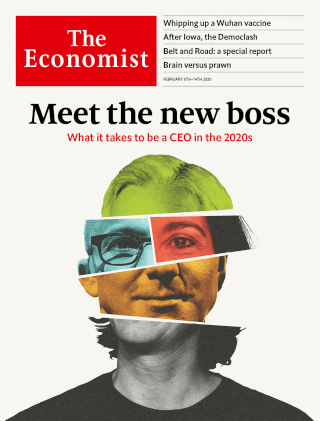The subject of how companies should be run is an enduring one. Business Schools and business gurus peddle endless creative solutions, making a good living at theorising and pontificating about it. The incomplete leader, the Level-5 leader, the mindful leader, the servant leader, the integral leader, the inside-out leader, the transactional leader, the transformational leader – the list goes on. And on. In early 2020 The Economist even ran a cover story and leader on the subject – ‘What it takes to be a CEO in the 2020s’.

They write:
‘On paper, this is a Golden Age for bosses… Yet CEOs say the job has got harder. Most point the finger at “disruption”, the idea that competition is more intense. But they have been saying that for years. In fact, the evidence suggests that, as America’s economy has become more sclerotic, big firms have been able to count on cranking out high profits for longer. Nonetheless, bosses are right that something has changed. The nature of the job is being disrupted. In particular, CEOs’ mechanism for exercising control over their vast enterprises is failing, and where and why firms operate is in flux. That has big implications for business, and for anyone climbing the corporate ladder.’
They also said, ‘The only big drawback is all those meetings, which eat up two-thirds of the typical boss’s working hours.’ Now that’s a perennial problem if ever there was one! Many will remember John Cleese’s famous ‘Meetings, bloody meetings’ video originally from 1976, updated by Cleese in 2012.
Interestingly, thirteen years ago in 2003, The Economist wrote a piece about running companies called ‘How to run a Company Well: The Ten Commandments for Successful Leaders’. The article opened with the statement: ‘LEADING a big public company is one of the world’s most important jobs. It is already fiendishly difficult, and seems to be getting harder all the time.’
If it was ‘fiendishly difficult’ then, and now it’s even harder, what hope is there for any of us who are trying to run a successful company?

A Few Important Insights Into Life as a CEO
The Economist’s current leader-writer goes on to say that nothing is more ‘voodoo…than management’. Nevertheless, they offer some thoughts. In particular, they suggest there are four things that make the CEO’s task more difficult now than, say a few years ago:
- What do CEOs control? In the past CEOs exercised control over their firms through the process of capital allocation – they literally controlled the purse-strings, controlled what was built and what money was spent. Nowadays, says the Economist what is most valuable about firms is not the physical assets, it’s the intangible ones – things like brands, data, and connections.
- Where are the boundaries? When everyone and every process is in one place (or in a few places) what is ours is clear – we control what’s inside our walls. Nowadays, a big aspect of how companies work is the fact they’re not ‘owned’ by us. Everything is scattered, widely distributed, so we partner with others to make our businesses work. The premise behind success is collaboration, the alignment of distinct, separate entities.
- Who has the authority? When it’s clear who has control, and the boundaries are clear, as a CEO I can see I have the authority to dictate who does what and when. Even if my empire is global, I still have the authority to make things happen.
- The purpose of organisations has changed! In the old days, when capitalism was red in tooth and claw, the sole purpose of a business was to make money for its owners. Nowadays, that single focus is no longer acceptable. We are in business for a wide range of additional, super-ordinate goals. We have to promote our people’s well being, we have to be socially responsible, we have to be seen to be fully on-board with a whole range of contemporary shibboleths.
The Economist’s leader writer goes on to say that to overcome these increasing complexities CEOs need to possess a few core qualities:
- ‘Mastering the tricky, creative and more collaborative game of allocating intangible capital is essential’
- ‘Marshal[ing] … data flowing between companies and their counterparties, redistributing who earns profits and bears risks’
- ‘Be[ing] clear that a firm should be run in the long-term interest of its owners’.
If you aspire to be the CEOs of a large business, you should give some attention to this insight.
Mastering being creative and collaborative, marshalling data to keep track of profits and risks, and being clear why you are in business. Yes, being a CEO is difficult. It might still be fiendishly difficult. But it isn’t impossible. It simply means that the capabilities today’s CEOs need are softer and more subtle than those of earlier generations.
Ten key qualities every contemporary CEO needs

Back in 2003, it is worth noting that they thought a set of ten commandments was an appropriate metaphor. I doubt anyone nowadays would believe it had any resonance with leaders. Having said that, the things they said back then really do deserve a revival. Some things don’t change, and their thinking was pretty spot on when they said a successfully-run company demands ten key qualities:
- A sound ethical compass
- The ability to make unpleasant decisions
- Clarity and focus, both essential requirements for making awkward judgments
- Ambition
- Effective communications skills, a relatively new requirement thanks to the increasing intrusion of the media, analysts, shareholders, environmental groups and more
- The ability to judge people, given the importance of human capital
- A knack for developing talent that can be used to build a stock of future leaders.
- Emotional self-confidence
- Adaptability, invaluable when things go wrong
- Charm – not a quality taught on MBA courses, but few people get to the top without it. A bit of luck helps too, although that’s out of your control
It’s an enduring list. Enduring and important. It’s a set of characteristics many leaders today can and should aspire to. Note the prominence of ethics – “Don’t be evil” as Google used to say, or as Google’s parent company Alphabet now says “Do the right thing”.
Some you might want to reframe the ten key qualities slightly. You may want to add a few more, perhaps along the lines of celebrating difference in an increasingly diverse world, maybe looking at round building a deeper sense of responsibility around today’s Green Agenda.
A Last Thought
Bob Garrett, the Institute of Directors Strategy guru and author of the very perceptive book, The Fish Rots from the Head, says some important things about leading a company. His wisdom about what great Boards need applies to CEOs too. As he says:
‘Strategy is seeing – seeing ahead, seeing behind, seeing above, seeing below, seeing beyond, seeing beside, and finally seeing through…It is the ability to make better, more comprehensive, more imaginative pictures about the past, present and future which helps differentiate an effective Board from its competitors’
Bob Garratt The Fish Rots from the Head
If CEOs are to navigate our contemporary world and blaze a trail through everything that makes that role so difficult, they need to see and see and see in the way that Garrett is suggesting.
Explore your own capabilities as a CEO
Are you the CEO of a company and do you feel the isolation of the role? Are you in the middle of all the complexity? If you want a forum to explore how you can work on your own capabilities and improve the way you lead, our Leadership Narratives Programme might be just the thing for you. Contact us
About us:
We create the space for leaders to step back, think clearly, and navigate complexity with confidence. By sharpening the narrative that drives decisions, teams, and performance, we help leaders move forward with clarity and impact. Our approach blends deep listening, incisive challenge, and commercial focus—strengthening leadership at every level, from business transformation to boardroom decisions.
“We share resources that help coaches deepen their practice and expand their impact. The articles on this site are designed to spark fresh thinking, offer practical tools, and support the continuous growth of coaches at every stage. “
Jude Elliman
Founder
Our Core Approach:
We work with leaders to sharpen their thinking, strengthen their leadership, and navigate complexity with confidence. Our approach is built around three core areas:
Narrative Coaching – Working with the stories that shape leadership, teams, and organisations.
Commercial Focus – Cutting through complexity to drive clear, strategic decisions.
Challenge & Space – Asking the right questions while creating the space to reflect and grow.
Through this, we help leaders drive transformation, align teams, and make high-stakes decisions with clarity and impact.
